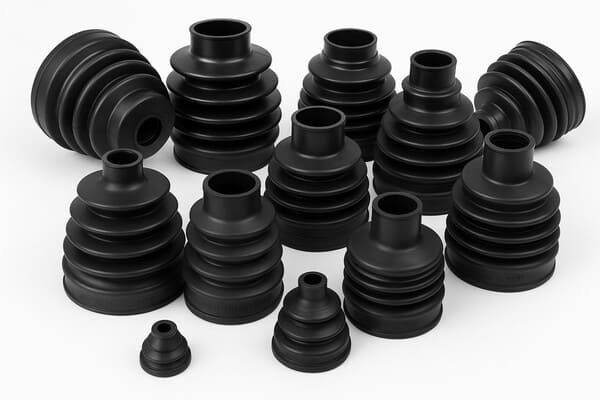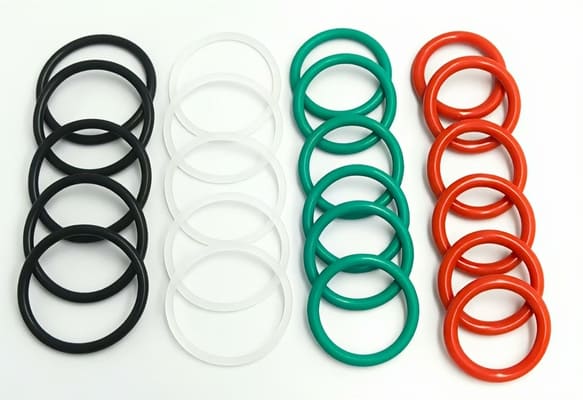Projects die when warehouses sit empty or cash locks in slow stock. MOQ feels like a wall. I help buyers turn that wall into a door.
Typical MOQ for custom rubber parts ranges from 200–3,000 pcs per SKU, driven by tooling method, part size, material, and color. You can lower MOQ with shared tooling, flexible specs, and staged releases.

I run a factory in China that molds seals, gaskets, hoses, and wheels. I balance press time, batch size, and scrap risk every day. In this guide, I show how MOQ really works and how I negotiate it with buyers.
What MOQ do factories usually require for custom rubber parts?
Urgent projects need parts now. Large MOQs can freeze your budget. I understand the pressure.
Most factories set MOQ between 200 and 3,000 pieces per SKU. Injection molding and colored silicone tend to sit higher; compression molding and black EPDM often sit lower.
Typical MOQ ranges I use
Typical MOQ ranges I use
| Process / Product Type | Common Material | Usual MOQ Band | Why this range matters |
|---|---|---|---|
| Compression-molded gaskets1 | EPDM / NBR | 300–1,000 | Moderate cycle time, quick tool change, low material waste |
| Injection-molded small seals2 | VMQ / NBR | 1,000–3,000 | High startup loss, runners, longer setup, faster cycles need batch size |
| Extruded hose/tube3 (cut lengths) | EPDM / VMQ | 200–800 meters | Continuous run favors longer footage; cutting and packaging drive labor cost |
| Large simple bumpers/bushings4 | NR / SBR | 200–800 | Large parts but fewer cavities; press time limits daily output |
| Colored silicone parts5 | VMQ (color) | 800–2,000 | Color matching waste and purge material raise economic lot size |
Notes from my floor
- Black compounds have the lowest purge cost. I can accept smaller lots.
- Medical or food-grade silicone needs strict post-cure and clean changeover. MOQ goes up.
- Multi-cavity tools reduce unit cost, but each shot yields more pieces, so economic MOQ rises.
I start every discussion with real capacity and waste assumptions, not a fixed number. That keeps the MOQ honest and practical.
What factors drive MOQ in rubber molding and extrusion?
MOQ is not a mood. It is a function. I calculate it from time, waste, and risk.
Four levers drive MOQ: setup cost, cycle economics, material loss, and quality risk. Each lever changes with process, part geometry, and compliance level.
The four levers explained
1) Setup and changeover
Tool heating, press calibration, and first-article checks take time. If I spend 2–4 hours on setup for a 30-minute run, the unit cost explodes. A bigger batch spreads that cost.
2) Cycle time and cavitation
Cavity count, runner design, and demolding method define parts per hour. High-cavity injection tools want longer runs, or the per-part cost climbs. Low-cavity compression tools allow shorter, flexible batches.
3) Material and color waste
Rubber has start-up scrap. Silicone adds color purge. Food-grade post-cure adds oven occupancy. These push the economic lot size up. Black EPDM or NBR keep waste low.
4) Quality risk and AQL6
Small batches still need sampling, PPAP (if required), and traceability. For a 200-piece batch, the cost of paperwork per part is high. Larger lots dilute this overhead.
Practical matrix for MOQ decisions
| Driver | Low MOQ Friendly | High MOQ Pressure |
|---|---|---|
| Setup time | Compression press with quick tools | Injection molds with complex runners |
| Material | Black EPDM/NBR | Colored VMQ, FDA-grade VMQ |
| Geometry | Thick, simple sections | Thin lips, long flow paths |
| Compliance | Industrial spec | Class VI/FDA food-contact |
| Finishing | No trimming, no bonding | Deflash, adhesive bonding, post-cure |
I show this matrix to buyers at RFQ. Together we decide where to relax and where to insist. That keeps the MOQ aligned with real needs.
How can I reduce MOQ without hurting quality?
I never promise magic. I promise options. Smart buyers trade “nice-to-have” for “need-to-have.”
You can lower MOQ by standardizing materials, sharing tooling, consolidating SKUs, accepting staged shipments, and using pilot lots that become PPAP or FAI lots.

Proven tactics I use with procurement teams
A) Standardize what you can
- Material: Choose a house EPDM 70 ShA (black) for HVAC gaskets. I keep it in stock.
- Color: Keep black for first run. Switch to colors after validation.
- Finish: Avoid tight flash trims unless critical.
B) Consolidate and mix
- Family molds: Place related sizes in one tool if geometry allows.
- Mixed SKUs: Run sizes A/B/C in one campaign. I change inserts, not the whole tool.
- Shared post-cure: Bake multiple items together when specs match.
C) Stage the volume
- Pilot batch (200–500 pcs): Treat it as FAI. Ship fast.
- Follow-up batch: Release after dimension sign-off.
- Frame order: Place a 6-month blanket; I schedule three smaller runs.
D) Simplify packaging early
Custom labels and small inner packs raise labor time. Start with bulk packs; switch later.
Sample playbook (realistic and buyer-friendly)
| Step | Action | MOQ Impact | Risk Control |
|---|---|---|---|
| 1 | Approve black EPDM/VMQ first | −30–50% | Material in stock, no purge |
| 2 | Agree on M2/M3 tolerance per DIN ISO 3302-1 | −10–20% | Use capability study to confirm fit |
| 3 | Combine two sizes in one run | −15% | Separate cavity IDs for traceability |
| 4 | Schedule 3 releases under a blanket PO7 | −25% cash stress | Fixed price, locked slots |
Every percentage here comes from saved setup, purge, and admin. The parts stay good. The math carries you.
Will small MOQs increase unit price, tooling, or lead time?
Low MOQ is not free. The cost must sit somewhere. I place it where it hurts the least.
Yes, unit price rises when MOQ drops, because fixed costs spread over fewer pieces. Tooling may not change, but lead time can grow if we wait for shared runs or material booking.

How price scales as MOQ changes
| MOQ Band (per SKU) | Typical Unit Price Effect vs. Baseline | Why it changes |
|---|---|---|
| 2,000+ | Baseline (100%) | Efficient press time, low admin per part |
| 1,000 | +8–15% | Fewer hours spread, same setup cost8 |
| 500 | +18–35% | Setup dominates, post-cure occupancy bites |
| 200–300 | +35–60% | Scrap and testing overhead become big |
| <200 (case-by-case) | Quote-specific | Pilot/engineering lot economics |
Tooling and setup
- Tooling cost stays the same, but the payback per unit slows with tiny batches.
- For injection molds with cold runners, I may suggest fewer cavities to lower economic lot size.
Lead time
- Short if material is in stock and we slot your run alone.
- Longer if we plan shared post-cure or wait for color masterbatch.
- Best practice: approve the spec, place a blanket, and let me reserve oven time.
I tell buyers to compare “price × risk.” Cheap parts that arrive late or fail audits cost more in the end. The right MOQ lowers total cost.
Can I run trial orders, mixed SKUs9, or color splits?
Yes. I build plans that protect speed and data. Trials reduce surprises later.
You can start with a 100–300 piece pilot or a short footage run for hoses. You can mix SKUs under one material and cure plan. You can split colors after validation.

Pilot strategies I use
Pilot lot → Production lot
- Pilot: 100–300 pcs (or 100–200 m hose) with full dimensions and basic AQL.
- Carryover: If pilot passes, these become your first production pieces.
Mixed SKUs under one run
- Same base compound and cure.
- Insert changes allow size swap without full teardown.
- One post-cure batch, separated by labeled trays.
Color split after approval
- Validate in black first.
- Add color in the second or third campaign.
- This avoids small, costly color purges at the start.
Documentation flow that keeps pilots useful
| Stage | File Set | Purpose |
|---|---|---|
| T0 samples | Dimensional report + material cert | Geometry confirmation |
| Pilot run | AQL record + oven log + batch ID | Stability and repeatability |
| Mass run | COA + EN 10204 3.1 (if needed) | Release and traceability |
You get data you can keep. I get a smooth launch. Everyone sleeps better.
Do payment terms10 and Incoterms affect MOQ?
Cash flow and risk sit behind every MOQ discussion. I manage both with terms and logistics plans.
Yes. Payment terms and Incoterms change my working capital and risk. Friendlier terms or a clear logistics plan help me accept smaller MOQs and lock earlier slots.
How terms influence MOQ flexibility
| Lever | Buyer Option | Why it helps MOQ |
|---|---|---|
| Deposit | 30–50% deposit at PO | Locks raw material and oven time |
| Balance timing | Balance before shipment or telex release | Reduces AR risk on small batches |
| Incoterms11 | EXW/FOB for first two runs | Keeps risk simple and lead time short |
| Freight | Agree on consolidated express for pilots | Faster cash-to-learning loop |
| Blanket PO | 6–12 months with releases | Lets me schedule three small runs at good economics |
I am open to DAP/DDP and OA later, once we have a stable program. For the first runs, simple terms let me relax MOQ without adding risk premiums.
📌 Quick buyer checklist to secure a lower, realistic MOQ
- ✅ Approve a stock compound (e.g., EPDM 70 ShA black) first.
- ✅ Keep color for the second run.
- ✅ Combine sizes in one campaign when possible.
- ✅ Place a blanket with three releases.
- ✅ Accept bulk packs in the pilot.
- ✅ Start with a 200–500 pc pilot that becomes production if passed.
Why work with Julong Rubber on small or staged MOQs?
I run a high-mix, low-volume factory with in-house tooling, >40 vulcanization presses, and strict APQP control. I design economic batches that protect your cash and your deadline. I ship to Germany, France, the Netherlands, Sweden, and the UK with the documents your auditors expect.
- 🧪 Compression, injection, extrusion under one roof
- 🧰 CNC tool shop for fast inserts and family tools
- 📦 Flexible MOQs with blanket scheduling
- 📄 Dimensional reports, control plans, and 3.1 certificates on request
- 🌐 Factory-direct, B2B wholesale only
Explore more: www.rubberandseal.com
Send me your drawing, target MOQ, and next delivery window. I will build two batch plans with price, risk, and lead time.
Conclusion
MOQ is not fixed. It is calculated. Define the must-haves, standardize early, stage releases, and the “wall” turns into a door you can push open.
-
Explore the advantages of compression-molded gaskets for various applications and their efficiency. ↩
-
Learn about the process and benefits of injection-molded small seals in manufacturing. ↩
-
Discover the applications and advantages of extruded hoses and tubes in different sectors. ↩
-
Find out how large bumpers and bushings are utilized in various industrial applications. ↩
-
Understand the complexities and considerations in producing colored silicone parts. ↩
-
Learn about AQL (Acceptable Quality Level) and its significance in quality assurance. ↩
-
Understand the concept of blanket purchase orders and their benefits for procurement. ↩
-
Explore the key factors that affect setup costs and how to manage them effectively. ↩
-
Explore the advantages of running mixed SKUs in production for better resource utilization. ↩
-
Learn how payment terms can influence manufacturing agreements and cash flow. ↩
-
Explore the significance of Incoterms in international trade and logistics. ↩








